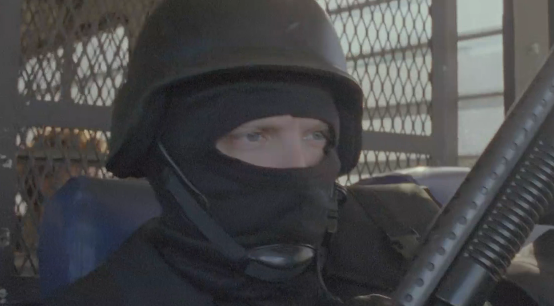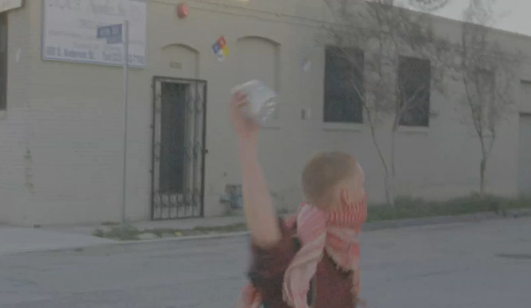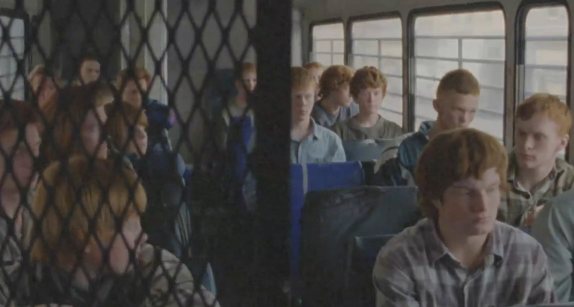The premise (reportedly the same as a feature film by director Romain Gavras), is simple, brutal, effective, and not immediately clear. The shootings and explosions in the last two minutes of the video make it easy to forget that the first shot of the bus’ interior is genuinely surprising. The pain and terror on the faces of the couple is palpable. It’s not until after the raid that we learn the rules of this alternate universe. Gavras rests the camera on the faces of a few of prisoners while the music calms; the viewer gets a minute to imagine how this came to be, to imagine why this war is raging, and to wonder if any of the gathered youths are actually guilty of anything. The video doesn’t give any answers to these questions. The men in riot gear gun down their prisoners. Even in a fictional world, they commit war crimes, and the video ends. It’s not uplifting.
Ann Powers of the LA Times managed to explain why the video is a success and to hint at why critics of M.I.A.’s latest move are so dismissive. She wrote on Tuesday:

“As one of the very few female pop artists whose work doesn’t primarily focus on gender and sexuality — she’s not writing love songs, neither is she making protest music specifically about the costs of beauty, glamour or ‘the (always feminized) fame’ — M.I.A. has to fight to keep her agenda undiluted. ‘Born Free’ is a heavy concentrating agent that fully shows M.I.A.’s intention to stay radical and aligned with her own vision of what’s real.”
In a Twitter exchange with Powers over M.I.A.’s agenda, critic Jessica Hopper dismissed the video as needlessly violent “like an episode of 24,” and called America’s racism too easy a target to be useful. She also implied that reactions were not universally negative only because M.I.A. is seen as a political artist. At the risk of sounding flip – duh. Statements from political artists are viewed in the context of their politics.
This is not M.I.A.’s first foray into political provocations and the debate over what actions are appropriate from a pop artist. After her video for “Paper Planes” was censored and the gun shot sounds removed, she protested via a furious statement on MySpace. She has spoken out in support of the Tamil Tigers, the terrorist group of which her father was a high-ranking member. Neither incident stirred much notice in the US, although there is a strong and vocal opposition to M.I.A. in Sri Lanka because of her statements about the Tigers.
It’s no small thing that M.I.A.’s work is controversial in Sri Lanka because of her political stances while in the U.S. people argue over whether the images that accompany her music undermine her perceived radical arguments. M.I.A.’s actual radical views have been, until now, something of a non-issue to the US mainstream. Now that she’s released something that should make it impossible to skirt the issue, people are still managing to avoid this confrontation by focusing on the wrong elements of the video.

The most frustrating of these digressions are the ones about that suggest that the allegory is a Romain Gavras product with an M.I.A. soundtrack rather than an M.I.A.-approved collaboration. In another tweet from Monday, Hopper cited Gavras’ violent video for the French electro band Justice’s song “Stress” as evidence that viewers should not read any political meaning into “Born Free,” and at least one commenter on pop culture site The A.V. Club stated that he wouldn’t call the video political until Gavras said it was meant to be. Both comments erase M.I.A. from the dialogue. She is an accomplished visual artist and an international star who has been intimately involved in all aspects of her music and its packaging up until now, and it is absurd to that she would stop. Simply put, M.I.A. is smart enough to know what kind of statement this video would make, and she is powerful enough to have said no if it did not meet her standards.
The fact that M.I.A. can simultaneously be erased from a discussion of her own work and criticized for violating the rules of good taste with the same work perfectly illustrates how difficult it is to for women, and especially women of color, to start difficult discussions about sex, violence and race. Luckily, M.I.A. is not the only woman making that effort. It’s heartening that “Born Free” continues what is starting to look like a positive trend of thought-provoking music videos by female artists.
The two other major video events of the past six weeks, “Telephone” and “Window Seat,” feature the artists front and center, which makes sense given the context Lady Gaga and Erykah Badu have created for themselves. The director of “Telephone,” Jonas Akerlund, directed “Smack My Bitch Up” by the Prodigy, a video so rife with violence against women that it could only be played in the middle of the night, and yet no one questioned whether Lady Gaga had any input on “Telephone.” Her image was the main focus. The conversations that followed their videos (about gender and transphobia, and about perceptions of black female sexuality) wouldn’t work without them. Powers makes this point as well, but it’s worth repeating: “Born Free” wouldn’t work with M.I.A. in it. Maybe this is why it’s so easy to separate her from the video. By keeping herself out of the story, the viewer has nothing to distract from the abuses heaped upon the persecuted redheaded men.
Yes. WHAT ABOUT THE MEN. By focusing on the overtly/specifically graphic moments in the video, one ignores the whole point of the video: it’s awful to watching such terrible things happen to someone like you. Getting outraged is the whole point. Racial and ethnic distinctions are often as arbitrary as hair color, but it’s easy for people to ignore that fact when physical characteristics are our first test of otherness.

The U.S.’s dealings with the Other are currently abysmal. Arizona’s new law legalizes racial profiling. We can only speculate about how many men have died in U.S. custody at military prisons around the world. The War on Terror is now so shamelessly a war on Islam that European nations support public bans on the burka. In a global environment so openly hostile, it’s hard to see any artistic response to racism and violence as too obvious. M.I.A. should be applauded for shocking us into talking about it.
